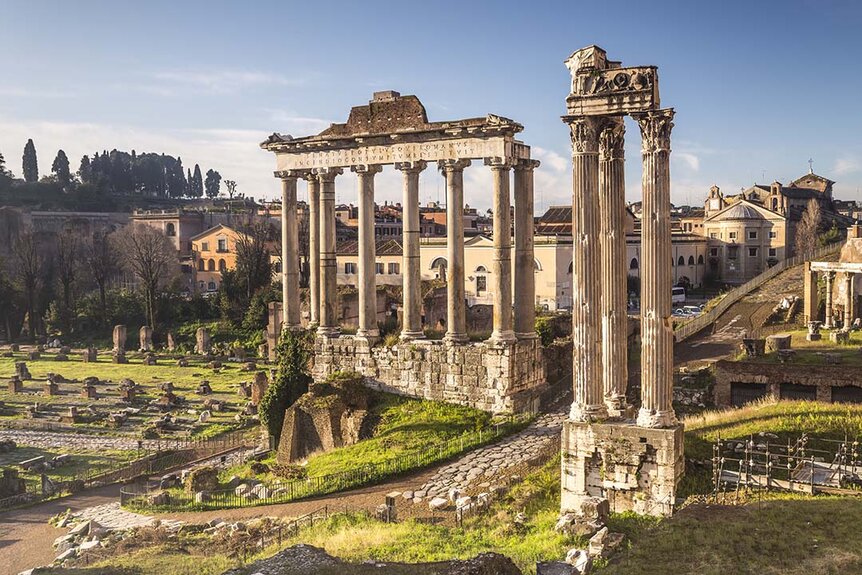Create a free profile to get unlimited access to exclusive videos, sweepstakes, and more!
Scientists may have found the secret ingredient that makes Roman concrete so sturdy
We have a lot to learn from the past.

The past is, by and large, a black box. Once a moment is gone we have to rely on memory and whatever physical evidence might be left behind, both of which degrade over time. It’s a wonder we know anything at all when so much of what we see is the archaeological equivalent of shadow puppets, especially once we realize we’re seeing those shadows through the lens of our own biases.
We believe that because they lived such a long time ago, ancient peoples were necessarily less advanced than us. How then, we ask, did they manage to build such incredible structures without the benefits of our comparatively infinite knowledge and incredible technology? It’s the sort of question which invites speculation and conspiracy, even the invoking of extraterrestrial assistance, so says the panel of experts on Ancient Aliens, now streaming on Peacock.
The truth, of course, is that ancient peoples were a lot smarter than we give them credit for. While pyramids and Stonehenge are the targets of the greatest number of alien conspiracies, there has long been a mystery surrounding Roman construction, as well. While pyramids rely largely on the geometric stability of the pyramid shape, the Romans were able to craft complex buildings like the Colosseum through the use of concrete.
RELATED: Scientists create moveable Stonehenge-sized slabs to recreate ancient mysteries
But, wait a minute, we use concrete and it sucks compared to theirs. Modern concrete breaks down much more quickly and would require significant maintenance in order to stand the same test of time. It’s that disparity between our concrete construction abilities which has tickled at the brains of archaeologists for years. Now, an international team of scientists may have cracked the Roman concrete code, according to a new study published in the journal Science Advances.
An international team of scientists gathered samples of 2,000 year old concrete from a city wall at Pivernum. They were interested in macroscopic inclusions of lime which have previously been handwaved as an artifact of incomplete mixing or low-quality materials. But those assumptions didn’t jive with the fact that Roman buildings are among the most durable in the world.
The recent study revealed that these white chunks of lime in Roman concrete weren’t mistakes at all and were in fact the thing that allowed their structures to survive as long as they have. The white chunks are known as lime clasts and they are believed to have formed through the use of quicklime and hot mixing at high temperatures. Rather than the imperfections we once believed them to be, lime clasts serve as a sort of artificial immune system for buildings, healing damage and sealing cracks before they can get worse.
To see the lime clasts in action, researchers made a couple of batches of concrete themselves. One used the modern concrete method which mixes cement (generally limestone, water, and sand) with gravel or small stones. The second batch was made according to the Roman recipe. Researchers used their concrete to build matching objects and then intentionally cracked them. After a couple of weeks, the Roman concrete had repaired itself enough that water could not flow through the crack. The same could not be said of the modern version.
Their findings demonstrated that when exposed to water, the lime clasts dissolve and trickle into any cracks where they recrystallize, effectively healing the wound. Because these lime clasts are distributed throughout the concrete matrix, it makes their constructions incredibly robust and able to stand up against all kinds of natural weathering with comparatively little long term damage.
Today, concrete is one of the largest contributors of global greenhouse gas emissions. It’s estimated that each pound of concrete produced releases 0.93 pounds of carbon dioxide and concrete accounts for approximately 8% of total global carbon emissions. Implementing what we’ve learned from Roman concrete could allow us to make buildings which last longer, reducing both the repair cost and carbon footprint of our construction projects.
You know what they say: if you don’t learn from the clast, you’re doomed to repeat it. And, in this one instance, no matter where you are, maybe we should do as the Romans do.
Check out even more ancient mysteries which definitely weren’t aliens but were totally aliens, in Ancient Aliens: The Ultimate Evidence, now streaming on Peacock!



























